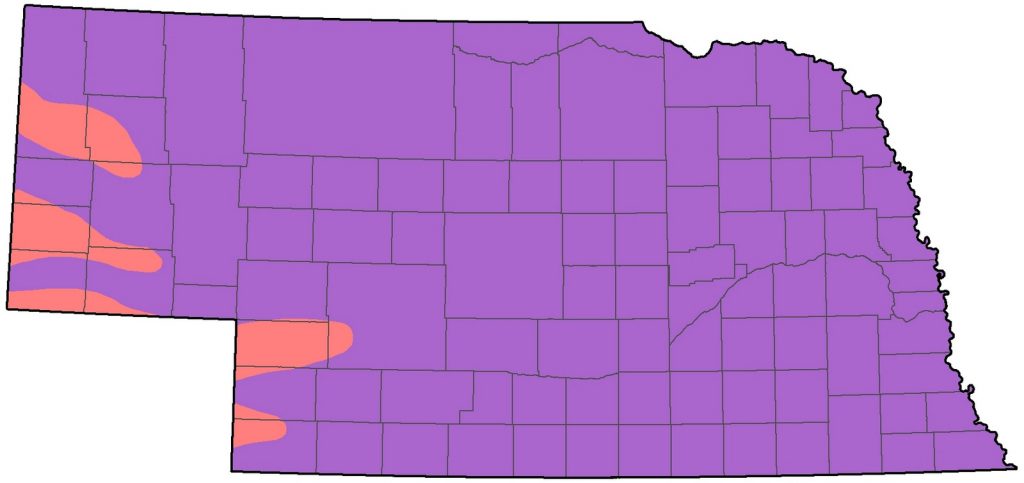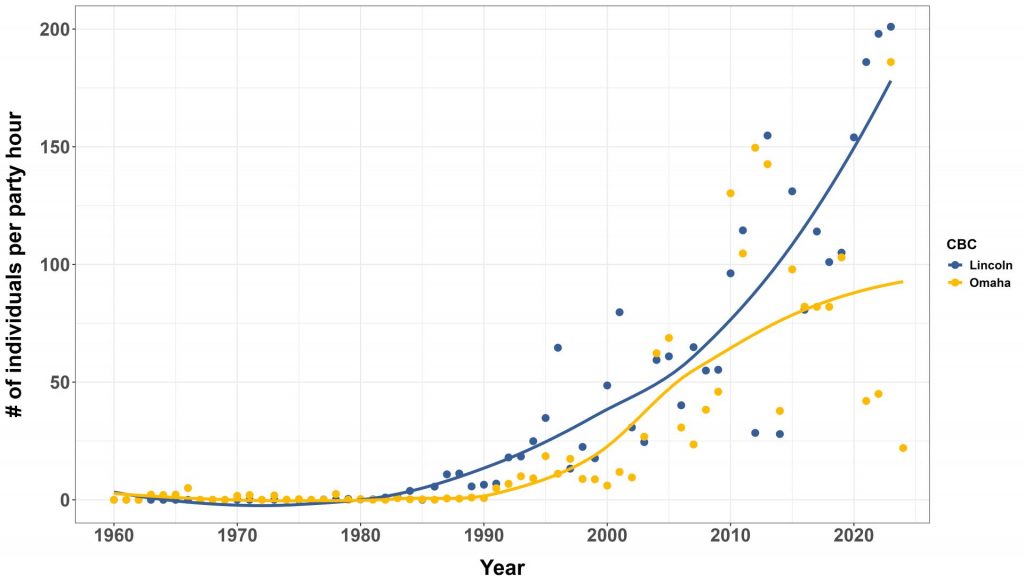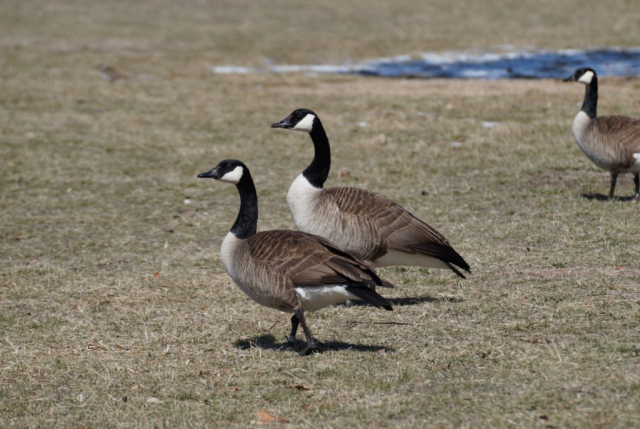Branta canadensis interior, B. c. parvipes, B. c. maxima, and B. c. moffitti
Status: Abundant regular spring and fall migrant statewide. Common regular resident statewide. Locally abundant regular winter visitor statewide.

Documentation: parvipes: specimen FMNH 400971, 30 miles south of Wood Lake, Cherry Co; maxima: specimen UNSM ZM16581,11 Mar 1989 Buffalo Co (culmen 58.9).
See Comments for information on documentation of Nebraska moffitti and interior.
Taxonomy: Among the 11-12 subspecies of Canada Goose previously recognized, genetic studies have shown that two clades can be differentiated, seven large subspecies in one and four small subspecies in the other (Banks et al 2004, AviList 2025). Banks et al (2004) designated these two groups as full species, the newly designated species Cackling Goose (B. hutchinsii) consisting of four small subspecies hutchinsii, taverneri, minima, and leucopareia; the remaining seven large subspecies were retained in Canada Goose (B. canadensis). These seven subspecies are canadensis, interior, maxima, moffitti, parvipes, occidentalis, and fulva. Of these, canadensis is restricted to the eastern United States and occidentalis and fulva to Alaska and the Pacific Coast. The remaining four subspecies occur in the interior United States, including Nebraska. As shown in Baldassarre (2014), maxima is resident in the entire eastern United States north to southern Canada, and moffitti is resident in the entire western United States north also to southern Canada; their ranges meet in central Nebraska. Baldassarre (2014) depicts the range of parvipes as breeding in northwest Canada and central Alaska, north to the Arctic Ocean only in Canada, wintering in two areas, the northwest United States and the south-central Great Plains, including southwestern Nebraska. Baldassarre (2014) depicts the range of interior as breeding in a large area around Hudson Bay and south well into Ontario and Quebec, wintering throughout the eastern United States, including only extreme western Iowa, most of Missouri, eastern Kansas and eastern Oklahoma, but not including Nebraska.
Current understanding (Silcock 2006, Baldassarre 2014) is that moffitti and maxima are year-round residents of at least the Nebraska Panhandle and the eastern half of Nebraska respectively, parvipes migrates through the western two-thirds of Nebraska, its winter range occasionally including southwest Nebraska, and interior migrates rarely through the Missouri River Valley and may winter in southeast Nebraska.
See Comments for further discussion, particularly regarding the status of parvipes as a taxon, proposed synonymization of maxima, moffitti, and interior with canadensis, and timing of migrations of interior and parvipes.
Hybrids of Canada Goose and other species have been reported in Nebraska; see Snow Goose x Canada Goose, Ross’s Goose x Canada Goose, Greater White-fronted Goose x Canada Goose, and Swan/Graylag Goose (domestic type) x Canada Goose.
Spring: Although Canada Geese are found throughout the state year-round, large migratory movements are evident, varying to some extent by subspecies and population. Spring movement peaks in early to mid-Mar, as evidenced by high counts cited below.
The only spring records of “canadensis Group” (per eBird) are from the west and central, likely parvipes; there are five such records 2-11 Mar, and later records 8 Apr 2023 Buffalo Co and 30 May 2021 Scotts Bluff Co.
- High counts: 100,000 at Funk WPA, Phelps Co 12 Mar 1994, 100,000 in the Rainwater Basin 5 Mar 1995, 100,000 at Funk WPA 11 Mar 2001, 100,000 between Kearney, Buffalo Co and Gothenburg, Dawson Co 8 Mar 2007, 100,000 at Ponca SP, Dixon Co 10 Mar 2018, 100,000 in Sarpy Co 15 Mar 2019, and 100,000 in York Co 10 Mar 2023.
Summer: Breeding Canada Geese in the central Great Plains and in Nebraska were essentially extirpated in the early 1900s as a result of commercial hunting, unrestricted taking of eggs and loss of habitat (Hanson 1997). Re-introduction efforts began in the 1930s and 1940s (NGPC), resulting in dramatic increases of breeding numbers; there were around 10,000 breeding pairs of Canada Geese in Nebraska, distributed statewide, with the largest population (4000 pairs) in the Sandhills. A recent analysis using band recovery data for the years 2010-2016 shows the number of breeding Canada Geese in the state is approximately 150,000 (Lyons and Vrtiska 2018). In some urban settings, especially golf courses and parks, Canada Geese have become and are considered a nuisance. A high count was the 560 adults and young at Scottsbluff WTP, Scotts Bluff Co 21 Jun 2022.
There are no Nebraska records of “canadensis Group” (per eBird) for Jun-Sep. See Spring and Fall.
- Breeding phenology:
- Tending nest site: 1 Mar
- Nest building: 19 Apr
- Eggs/Incubation: 12 Mar-17 Jun
Dependent (downy) fledglings: 10 Apr- 30 Jul
Fall: “canadensis Group” per eBird: east (likely interior): 21, 26, 29 Oct <<<>>> winter; west and central (likely parvipes): 7, 11, 12 Nov <<<>>> 28, 29, 29 Dec.
One reported as a “Lesser” with a “very stubby bill” in Red Willow Co 21 Sep 2024 was quite early for a smaller migrant subspecies.
Later dates in the west and central, likely parvipes, are 16 Jan 2021 Morrill Co, and 17 Feb 2015 Scotts Bluff Co (see Winter).
Migrant Canada Geese are noticeably smaller than resident geese; most are parvipes, although interior occurs in the extreme east, where they are difficult to separate from larger resident geese. In Dakota Co in 2023, 60 “smaller bodied smaller billed” Canadas arrived 13 Nov, increasing within a mixed sized flock of 400 by 30 Nov (Bill Huser, eBird.org); these were probably interior. A flock of 2020 at Flanagan Lake, Douglas Co 26 Nov 2023 consisted of about “half migrators” (Eric Bents, eBird.org).
Nebraska’s breeding geese, being of the largest subspecies moffitti and maxima, are essentially resident, although many, usually younger birds or failed breeders, undertake a molt migration northward in late May- early Jun as far as Hudson Bay and return in Sep-Oct after molting (Abraham et al 1999). It has been found that the large numbers of molt-migrant large Canada Geese are interfering with brood-rearing of northern breeding geese, notably in western James Bay (Abraham et al 1999).
- High counts: 36,900 in the Kearney, Buffalo Co area 21 Dec 1996, 30,575 at North Platte NWR, Scotts Bluff Co 16 Dec 1996, and 20,000 in the Kearney area 16 Dec 1995.
Winter: The largest over-wintering populations occur in the North Platte River Valley, including Lake McConaughy, Keith Co, where about 12,000 overwinter (Rosche 1994), in Scotts Bluff Co, where similar numbers occur; and at Sutherland Reservoir, Lincoln Co, where up to 52,000 overwinter (NGPC). In the South Platte River Valley, 10,002 were at Swanson Res, Hitchcock Co 15 Dec 2018. Large numbers also winter along or near the central Platte River Valley; 46,000 wintered at Grandpa’s Steakhouse Pond, Kearney in 1997 (NGPC). Large numbers winter in the vicinity of Harlan County Reservoir, in the vicinity of Sherman Reservoir, Sherman Co, along the eastern Platte River Valley in Douglas and Saunders Cos, and on the Lancaster Co lakes. Most wintering birds around Omaha and Lincoln are local breeders and number have increased markedly within the past fifty years (Figure 1). Since 2012, up to 9000 have wintered on Carter Lake, Omaha.
The dates listed under Fall (above) suggest that few parvipes and/or interior winter in Nebraska. Regarding parvipes, Mowbray et al (2020) state: “Shortgrass Prairie Population Canada Geese (B. c. parvipes) arrive at major staging areas in se. Alberta and sw. Saskatchewan in early Sep … birds remain at staging areas until forced out by weather; first arrivals at wintering areas in se. Colorado, ne. New Mexico, and nw. Texas mid-Nov; migration usually complete by 15 Dec…”.
Figure 1. Number of Canada Geese recorded per party hour for the Lincoln and Omaha Christmas Bird Counts (CBCs) during the period 1960 to 2023. Points represent reported values and trend line created using locally weighted scatterplot (LOESS) smoothing. Data collected by volunteers and provided by National Audubon Society and the Nebraska Ornithologists Union.
Comments: Occurrence of the largest subspecies maxima and moffitti in Nebraska is fairly well understood (Silcock 2006, Baldassarre 2014), but that of the almost-as-large eastern subspecies interior is not well-documented, and there are questions about the identity and genetic make-up of small Canada Geese, generally assumed to be parvipes, in the state. Note that Pyle (2025) synonymized moffitti, maxima, and interior with canadensis based on none meeting the generally accepted 75% rule for subspecies diagnosability.
Regarding interior, Mowbray et al (2020) and Baldassarre (2014) indicate that it is at the west edge of its migration corridor in extreme eastern Nebraska. We are unable to locate a Nebraska specimen of interior, although photographs of interior were taken 12 Nov 2017 at Kiwanis Park, Pottawattamie Co, Iowa, adjacent to Carter Lake, Douglas Co, Nebraska (eBird.org, accessed 14 Apr 2018, https://ebird.org/view/checklist/S40473907). There were six reports in the east 21 Oct-30 Nov 2020 of the “canadensis” group as designated by eBird; the easterly locations of these sightings and accompanying photos indicate subspecies interior. A total of 404 Canada Geese collected in the central Platte River Valley 1884-1885 (DuMont and Swenk 1934) was assigned to subspecies by non-overlapping culmen measurements; 160 of the 404 specimens were assignable to subspecies using this criterion and of those, 44% were designated interior by Silcock (2006) but given current knowledge of Canada Goose subspecies’ ranges are almost certainly parvipes. Other possibilities are that interior occurred further west in the 1880s than it does today or that these birds were from the extensive zone of overlap between presumed interior and hutchinsii on the western shore of Hudson Bay wherein measurements include the entire range from hutchinsii to interior (Leafloor et al 2013); it would seem unlikely, however, that a random sample of these birds reaching Nebraska would approach the culmen measurements discussed in Silcock (2006). It should be noted that DuMont and Swenk (1934) lumped canadensis and interior in describing the 1884-1885 specimens.
The status of parvipes as a taxon has long been questioned. Mowbray et al (2020) describe it as “a heterogeneous taxon” that hybridizes with B. hutchinsii taverneri in west-central Alaska, with B. h. hutchinsii throughout the tundra portion of its range, and with B. c. maxima and B. c. moffitti to the south and southeast. Thus it is not surprising parvipes is difficult to identify in the field.
There is some evidence that interbreeding of taverneri and hutchinsii may be limited. It is generally thought that Cackling Geese breeding on the North Slope of northeast Alaska and northwest Canada are taverneri (for example, Baldassarre 2014) and that intergrades between taverneri and hutchinsii are likely to be present in this area, which appears to be an overlap zone between these two taxa (Steven Mlodinow, personal communication, Abraham 2005). However, Mlodinow et al (2024) note that “Taverner’s Cackling Goose and minima Cackling Goose favor different habitats in the Yukon-Kuskokwim Delta and there is no obvious phenotypic cline between these parapatric populations”. An intriguing alternative is synonymization of B. h. taverneri with B. c. parvipes, as proposed by Pyle (2025) based on 75% subspecies diagnosability not being met between the two taxa.
Interestingly, all recoveries of molting white-cheeked geese banded in these areas of Arctic tundra have come from east of the Rockies (C. Ely, cited by Mlodinow, 2008). As noted by Mlodinow (2008), “it seems unlikely that none were the local breeders”, and thus an unknown number of taverneri or taverneri intergrades may winter on the Great Plains, including Nebraska. Clearly, identification of such birds presents a major challenge in Nebraska, given the large numbers of hutchinsii and especially B. canadensis parvipes present.
We have been unable to document occurrence of moffitti with tangible evidence within Nebraska, although all current authors agree that it is present in most of Nebraska, especially westward. It is difficult to conclusively separate moffitti from maxima in Nebraska due to extensive overlap in their ranges and likely interbreeding.
The largest subspecies, maxima, was thought to be extinct in the 1950s, but a flock of 200 was discovered in a Rochester, Minnesota park in Jan 1962 (Hanson 1997, Baldassarre 2014).
A recent proposal to separate Canada Goose into six species and around 200 subspecies (Hanson 2006, 2007) has been met with skepticism (Banks 2007); there is a need for more information regarding breeding ranges of the many forms of this species before its taxonomy can be accurately delineated (Mowbray et al 2020).
Images
Abbreviations
CBC: Christmas Bird Count
FMNH: Field Museum of Natural History, Chicago
NGPC: Nebraska Game and Parks Commission
NWR: National Wildlife Refuge
SP: State Park
UNSM: University of Nebraska State Museum
WPA: Waterfowl Production Area (Federal)
WTP: Water Treatment Plant
Literature Cited
Abraham, K.F., J.O. Leafloor, and D.H. Rusch. 1999. Molt migrant Canada Geese in northern Ontario and western James Bay. Journal of Wildlife Management 63: 649-655.
AviList Core Team, 2025. AviList: The Global Avian Checklist, v2025. https://doi.org/10.2173/avilist.v2025.
Baldassarre, G. 2014. Ducks, geese, and swans of North America. Johns Hopkins University Press, Baltimore, Maryland, USA.
Banks, R.C. 2007. Book review: The White-cheeked Geese: Branta canadensis, B. maxima, B. “lawrensis”, B. hutchinsii, B. leucopareia, and B. minima: Taxonomy, ecophysiographic relationships, biogeography, and evolutionary considerations, vol. 1: Eastern taxa. Wilson Journal of Ornithology 119: 514-515.
Banks, R.C., C. Cicero, J.L. Dunn, A.W. Kratter, P.C. Rasmussen, J.V. Remsen, Jr., J.A. Rising, and D.F. Stotz. 2004. Forty-fifth supplement to the American Ornithologists’ Union check-list of North American birds. Auk 121: 985-995.
DuMont, P.A., and M.H. Swenk. 1934. A systematic analysis of the measurements of 404 Nebraska specimens of geese of the Branta canadensis group, formerly contained in the D.H. Talbot collection. NBR 2: 103-116.
Hanson, H.C. 1997. The Giant Canada Goose. Revised Edition. Southern Illinois University Press, Carbondale, Illinois, USA.
Hanson, H.C. 2006. The White-cheeked Geese: Branta canadensis, B. maxima, B. “lawrensis”, B. hutchinsii, B. leucoparei and B. minima: Taxonomy, ecophysiographic relationships, biogeography, and evolutionary considerations, vol. 1: Eastern taxa. Blythe, CA: AVVAR Books.
Hanson, H.C. 2007. The White-cheeked Geese: Branta canadensis, B. maxima, B. “lawrensis”, B. hutchinsii, B. leucopareia, and B. minima: Taxonomy, ecophysiographic relationships, biogeography, and evolutionary considerations, vol. 2: Western taxa. Blythe, CA: AVVAR Books.
Leafloor, J.O., J.A. Moore, and K.T. Scribner. 2013. A hybrid zone between Canada Geese (Branta canadensis) and Cackling Geese (B. hutchinsii). Auk 130: 487-500.
Lyons, T., and M. Vrtiska. 2018. Banding Canada Geese. NEBRASKALAND 96 (8; October): 56-57.
Mowbray, T.B., C.R. Ely, J.S. Sedinger, and R.E. Trost. 2020. Canada Goose (Branta canadensis), version 1.0. In Birds of the World (P. G. Rodewald, Editor). Cornell Lab of Ornithology, Ithaca, NY, USA. https://doi.org/10.2173/bow.cangoo.01.
Pyle, P. 2025. A Practical Subspecies Taxonomy for North American Birds. North American Birds 76(1).
Rosche, R.C. 1994. Birds of the Lake McConaughy area and the North Platte River valley, Nebraska. Published by the author, Chadron, Nebraska, USA.
Silcock, W.R. 2006. White-cheeked Geese in Nebraska. NBR 74: 99-105.
Recommended Citation:
Silcock, W.R., and J.G. Jorgensen. 2025. Canada Goose (Branta canadensis). In Birds of Nebraska — Online. www.BirdsofNebraska.org
Birds of Nebraska – Online
Updated 8 Sep 2025

